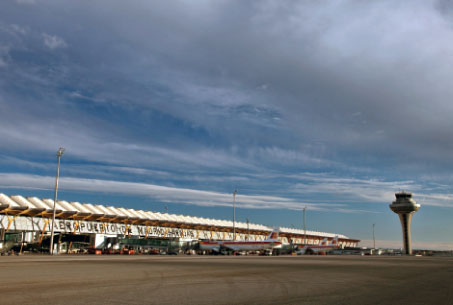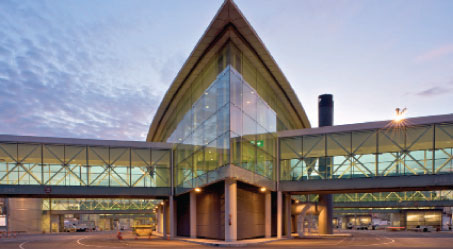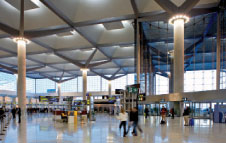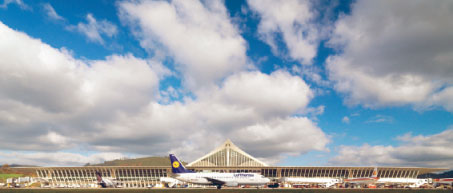
Vargas Gómez: “Madrid-Barajas is clearly the most relevant airport in Europe in terms of connectivity with Latin America and we’ll see that position being reinforced looking to the future.”
The economic picture in Spain is fundamental to the strategic objectives of the state-owned Aena Aeropuertos. The country’s banks have just required a bailout and GDP shrank by 0.3% in the first quarter of 2012, while Spain’s unemployment currently stands at 24%. The new Spanish government, installed in December 2011, appointed Vargas Gómez at what is certainly a critical time for the airport operator. The sovereign debt crisis and uncertain economic situation has altered the course of Aena Aeropuertos’ proposed privatisation process.
Aena’s airports and air navigation activities were separated in June 2011, when the new Aena Aeropuertos was created. The initial priority was to seek institutional investors, with privatisation of the management of the key Madrid-Barajas and Barcelona-El Prat airports on a concession basis identified as a suitable way to raise revenue. However, that process has since been reversed, with the priority now being to reinforce the network position of Aena Aeropuertos as a whole. While the creation of Aena Aeropuertos and the modernisation of the management structure are still expected to increase the overall value of the company, this is now part of a longer-term strategy.

Vargas Gómez: “The current situation is that we have put in place a strategic plan in order to unlock the value that we feel the company has; once we believe that value has been realised, we will think about going forward with the privatisation process.”
Vargas Gómez is impressively focused. The most frequently used word throughout the interview is “efficiency”, and it is abundantly clear that he is single-minded in achieving this overriding strategic objective. “My main priority when I arrived at Aena was to put in place a plan to guarantee the viability of the company, according to the current financial circumstances in Spain and throughout Europe,” he explained. “The current situation is that we have put in place a strategic plan in order to unlock the value that we feel the company has; once we believe that value has been realised, we will think about going forward with the privatisation process. Two things are important before any privatisation decision – the strategic value of the company and that the markets are in a position to be able to invest. The debt crisis is affecting the markets and is therefore instrumental in our strategy in terms of privatisation.”
Despite the economic situation, Aena Aeropuertos is not considering the possibility of closing any of its airports. “We are completing an Airport Efficiency Master Plan, which aims to improve the profitability of the 19 airports in our network with less than 500,000 passengers per year by implementing measures such as flexibility, keeping multi-role staff and reducing costs,” said Vargas Gómez.
Major infrastructure investment
Aena Aeropuertos has made extensive capacity enhancements in recent years, with impressive developments at several airports across the network. These investments have given Spanish airports a real competitive advantage in terms of the quality and capacity of their facilities. €6.2 billion was invested in Plan Barajas between 1996 and 2006, the most celebrated element of which was the much praised new Terminal 4 at the Madrid airport, which opened in 2006 and increased the airport’s overall capacity to 70 million passengers per year.

Barcelona-El Prat enjoyed growth of +17.8% to 34.4 million passengers in 2011 – an annual record for the airport and particularly impressive in the context of the economic crisis.
Meanwhile, Barcelona-El Prat’s €1.3 billion Terminal 1 opened in 2009, increasing the airport’s capacity to 50 million annual passengers. Aena Aeropuertos’ investments aren’t limited to its two major airports; Plan Málaga is an ambitious project in which €1.8 billion is being invested between 2004 and 2013, doubling the airport’s capacity to 30 million passengers per year. Central to this is Terminal 3, which opened in 2010. Alicante Airport has also seen a €670 million modernisation that has thoroughly enhanced the passenger facilities, while a new €230 million terminal opened at Santiago de Compostela Airport in September 2011. “The unprecedented level of investment in airport infrastructure in the last decade has changed the landscape of Spanish airports. However, the priorities of the company are no longer in infrastructure investment. After the last 10 years, we have a very good infrastructure network and our priorities right now are to extract the value and to really develop an efficient company. I think that we have enough capacity for the short-term,” said Vargas Gómez.

Vargas Gómez: “We are completing an Airport Efficiency Master Plan, which aims to improve the profitability of the 19 airports in our network with less than 500,000 passengers per year by implementing measures such as flexibility, keeping multi-role staff and reducing costs.”
José Manuel Vargas Gómez, President & CEO, Aena
Biography
Prior to joining Aena, José Manuel Vargas Gómez was CEO of Vocento, the leading press group in Spain, from 2008. He was connected to Vocento for over 10 years; from 2000 to 2002, he was the Director of the Legal Department of Prensa Española, as it then was, and Secretary to the Board of ABC – the oldest national daily newspaper in Spain – from 2000 to 2005. He then held the position of Chief Financial Officer at Vocento for six years, before becoming CEO.
Mr Vargas Gómez served as Chief Financial Officer and Secretary General of JOTSA, SA in the Philipp Holzmann Group from 1995 to 2000, and worked at Price Waterhouse Audit from 1993 to 1995.
Strengthening network position
The network position of Aena Aeropuertos is unique, with its comprehensive portfolio of airports providing wide connectivity. The airport operator has identified a deficit in its connectivity with Asia as a crucial issue to address. It believes that Spain’s airports have a key role to play in facilitating connectivity between the Americas and Asia – where the aviation markets are enjoying much higher growth.
Aena has, in the past, collaborated with local authorities and economic stakeholders on the development of routes – a notable example being the Barcelona Air Route Development Committee, which was created in 2005 by Aena, the Catalan Autonomous Government, Barcelona City Council and the Barcelona Chamber of Commerce, to promote the development of new intercontinental routes from Barcelona Airport. This kind of collaboration is something Vargas Gómez is keen to develop further, particularly given the role of the Aena Aeropuertos network as an engine of economic growth. “I think that Aena’s airports are certainly very, very important for the Spanish economy and also for the local economies of the regions in which they are located,” he commented.

Vargas Gómez: "If you take into account that Aena Aeropuertos is the world’s largest airport manager by the number of passengers, it is logical that we have an aim of expanding our know how overseas and therefore we’ll be working to re-launch our international activities."
Airport Factbox
Aena Aeropuertos
Airports in Spain: 47
Interests Abroad: 26 airports
Annual Passengers: 204,386,371 in 2011
Key Airline Customers: 740 airlines in 2011, but only 251 of them carried more than 1,000 passengers
Number of Employees: 13,256 in 2011
Madrid-Barajas:
Annual Passengers: 49.7 million (2011)
Number of Destinations Served: 199
Ratio of Legacy v LCC carriers: 77% legacy, 23% LCC (2011)
Barcelona-El Prat:
Annual Passengers: 34.4 million (2011)
Number of Destinations Served: 183
Ratio of Legacy v LCC carriers: 50.5% legacy, 49.5% LCC (2011)
He also highlighted the significant role of Madrid-Barajas and Barcelona-El Prat as the major airports in the Aena Aeropuertos network. “Madrid-Barajas is clearly the most relevant airport in Europe in terms of connectivity with Latin America and we’ll see that position being reinforced looking to the future,” explained Vargas Gómez. “Barcelona is increasing its traffic very, very well. We see, also, that it is very much improving its connectivity with the Middle East and Asia.”
Emirates will launch services between Dubai and Barcelona in July, adding to the Middle East coverage already provided by Qatar Airways’ services to Doha.
While Madrid-Barajas’ traffic declined slightly in 2011 – by -0.4% to 49.7 million, Barcelona-El Prat enjoyed growth of +17.8% to 34.4 million passengers – an annual record for the airport and particularly impressive in the context of the economic crisis. The demise of Spanair, the second biggest carrier at Barcelona-El Prat, in January has had little impact on the airport, with Vueling’s expansion more than compensating for this setback. “The airport is performing very well; in fact, the figures are among the best in the network, so I think that the connectivity and traffic of Spanair has been absorbed by other airlines,” commented Vargas Gómez. Spanair had seen its share of traffic at Barcelona climb from 8% in 2000 to 14% in 2010. While Barcelona’s traffic increased by around +8% in January, the collapse of Spanair at the end of that month meant traffic was up by less than +1% in February and March. Growth accelerated to +4% in April as other carriers increased capacity and added routes to compensate for Spanair’s demise. The latest available figures, for April, show that the leading airlines at Barcelona-El Prat are now Vueling (30%), Ryanair (15%), easyJet (9%) and Iberia (5%).
Meanwhile, in terms of Aena Aeropuertos’ regional airports, the main goal is to adapt the costs of these airports to the current level of demand. “Certainly, there has been massive infrastructure investment in the regional airports, and we are living in a time in which the level of demand has diminished due to the economic crisis, therefore, we have to adapt the level of costs to that situation,” commented Vargas Gómez. Aena Aeropuertos’ international activities are also considerable and far-reaching. It is currently involved in the management of 26 airports worldwide and the company has renewed ambitions for developing those international airport management activities. “If you take into account that Aena Aeropuertos is the world’s largest airport manager by the number of passengers, it is logical that we have an aim of expanding our knowhow overseas and therefore we’ll be working to re-launch our international activities. It’s key for us to be able to export our knowhow and our management experience to other regions,” explained Vargas Gómez.
Commercial activities

Sustainability is key to the Aena Aeropuertos development strategy. Three of its airports are now Airport Carbon Accredited – Madrid-Barajas at the ‘Reduction’ level, and Barcelona-El Prat and Lanzarote airports both at the ‘Mapping’ level.
The proposed privatisation process can be seen as a further step towards Spanish airports becoming businesses in their own right and being managed as such. Vargas Gómez acknowledged that the entry of private capital would have the positive impact of bringing “more competitiveness”. “I think it would be a catalyst for the future development and growth of the company,” he commented.
In line with a more competitive approach, a key future goal for Aena Aeropuertos is the development of commercial activities. “I think we have quite significant room for growth in terms of commercial activities and real estate development. These opportunities probably cannot be exploited in the short-term, but certainly in the medium to long-term, we will have to develop them,” said Vargas Gómez.
Aena’s debt currently totals around €14 billion and with the current outlook, the development of commercial activities will be fundamental to securing the profitability of the Aena Aeropuertos network. “Our strategic plan is based on the fact that our company has a lot of value, which needs to be optimised. In order to extract that value, we have to work on developing commercial revenues and we have to develop our aeronautical revenues; we are working on every line of the profit and loss account. We expect profitability to grow significantly in the coming years,” explained Vargas Gómez.
While acknowledging that the level of debt is substantial, he added that it is very well structured. Cost-cutting initiatives are underway across the company, and Vargas Gómez said it is “time for developing efficiency in every department – it is a common effort”.
One-bag rule

Plan Málaga is an ambitious project in which €1.8 billion is being invested between 2004 and 2013, doubling the airport’s capacity to 30 million passengers per year. Central to this is Terminal 3, which opened in 2010.
The one cabin bag rule being implemented by some low-cost carriers is THE issue currently most damaging to airports’ commercial activities in Europe. Retail revenues at those airports affected are down by as much as 50%, with the rule creating confusion among travellers and negatively impacting on the passenger experience. Crucially, last year Spain legislated to allow passengers to carry on items purchased in airport retail, “in order to avoid prejudicial practices to passengers’ rights and airports’ commercial activities”. Vargas Gómez asserted: “The legislation is a question of law and I expect this to be respected by all of the operators. The one-bag rule is important not only from a commercial point of view, but also in terms of passenger rights.”
Environmental sustainability
Sustainability is key to Aena Aeropuertos’ development strategy. Its Environmental Action Plan targets reduced carbon emissions and noise impact across the network. Madrid-Barajas, Barcelona-El Prat, Palma de Mallorca and Valencia airports already have advanced noise monitoring systems, which will be introduced at other airports in the network. In 2010, Aena invested €232 million executing its noise abatement plans, insulating more than 16,300 homes.
Three airports in the Aena Aeropuertos network are now Airport Carbon Accredited under ACI EUROPE’s institutionally-endorsed carbon management certification programme – Madrid-Barajas at the ‘Reduction’ level, and Barcelona-El Prat and Lanzarote airports both at the ‘Mapping’ level. “Environmental issues are increasingly important for airports. Accordingly, our environmental department works closely together with the management of our airports to address environmental issues,” explained Vargas Gómez.
As part of its carbon reduction efforts, in 2010 Madrid-Barajas was the first airport in the Aena Aeropuertos network to introduce Continuous Descent Approach (CDA), which generates a 25% reduction in both CO2 emissions and fuel consumption. CDA has since been introduced at several airports across the network.
Returning to a favourite theme of this interview, efficiency – Madrid-Barajas also signed up to ACI EUROPE & EUROCONTROL’s action plan on Airport-Collaborative Decision Making (A-CDM). The airport is currently in the process of fully implementing A-CDM to optimise its operations, to the benefit of the airport, ANSP (Air Navigation Service Provider) and its airline customers. Similarly, Aena is participating in SESAR (the technical arm of the Single European Sky project), with a keen eye on benefiting from the efficiency, environmental and financial gains expected from the programme.
From our time in his company, it’s evident that Vargas Gómez has a clear vision for Aena Aeropuertos – with efficiency front and centre of that vision. With the privatisation process postponed, the emphasis is now on reinforcing the network position of the world’s largest airport operator. “No question, there is a lot to be done within the company to implement the strategic plan I have talked about and to develop the efficiencies we are seeking. It will be challenging, but I think there is a huge opportunity for Aena Aeropuertos. I am sure that together with the quality of our team, the employees of the company and our customers, we will succeed,” concluded Vargas Gómez.

Vargas Gómez: “Certainly, there has been massive infrastructure investment in the regional airports, and we are living in a time in which the level of demand has diminished due to the economic crisis, therefore, we have to adapt the level of costs to that situation.”







